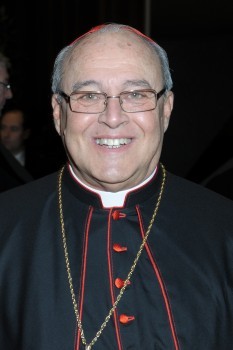Pope Francis sent his condolences July 27, 2019, after the death of Cuban Cardinal Jaime Lucas Ortega, Archbishop Emeritus of San Cristobal of Havana, who died at the age of 82 on July 26, 2019.
The pope expresses his «paternal proximity» to the clergy and the faithful of the archdiocese, in a Spanish telegram signed by Cardinal Secretary of State Pietro Parolin and addressed to the Archbishop of San Cristóbal of Havana, Mgr. Juan de la Caridad García Rodríguez.
He offered his prayers for the eternal rest of the deceased, «who served the Church and his brothers in the various offices that Providence entrusted to him» and conferred his apostolic blessing «as a sign of Christian hope in the risen Lord».
The Cardinal was born in Jagüey Grande in the diocese and province of Matanzas, Cuba, on 18 October 1936.
His father was first a worker in the sugar factory close to the village where he was born, and subsequently a shop-keeper.
When he was five years old, his family moved to the city of Matanzas. There he completed his compulsory education at the prestigious school Arturo Echemendía. He completed his higher education at the Advanced Institute for Secondary Studies of Matanzas, a state-run student center.
He earned a diploma in arts and sciences in 1955 and after one year at the university, entered the diocesan seminary of San Alberto Magno, directed by the Fathers of the Foreign Mission of Quebec.
After four years studying humanities and philosophy, the Bishop sent him to study theology at the seminary of the Foreign Mission in Quebec, Canada.
He then returned to Cuba and was ordained priest on August 2, 1964, in the Cathedral of Matanzas. His ministry as Coadjutor Vicar of Cárdenas was interrupted in 1966 when he was detained in work camps known by the initials UMAP. In 1967, at the end of his imprisonment, he was appointed parish priest of Jagüey Grande, his native town.
Like all parish priests in Cuba during this period when priests were few and far between, he was in charge of several parishes and churches. In 1969 he was appointed parish priest of the Cathedral of Matanzas. Responsible for the parish of Pueblo Nuevo in the city and another two churches outside it, at the same time he was also President of the Diocesan Commission for Catechesis and maintained an active apostolate with the youth of the Diocese. In those years, very difficult for the Church’s pastoral activities, he founded a youth movement, which included among the various forms of the apostolate summer camps for young people and evangelization by the means of theatricals, performed by the young people themselves.
For several years, in addition to his pastoral activities in the city of Matanzas, he taught at the Sts. Charles and Ambrose inter diocesan seminary in Havana, which he visited once a week to give courses in moral theology.
On 4 December 1978, John Paul II named him Bishop of Pinar del Rio. He was consecrated on January 14, 1979, in the Cathedral of Matanzas, and on January 21, he took possession of his diocese where he remained three years only.
On November 20, 1981, he was promoted to the Archdiocese of Havana as Archbishop. On December 27, he took possession of this new See. In charge of this Archdiocese for over thirty-four years (Pope Francis accepted his resignation on April 26, 2016), he created new parishes, set up the Diocesan Council for Pastoral Initiatives, rebuilt more than 40 churches and parish houses, founded a priests’ residence for the priests of the Diocese and of the whole of Cuba for meetings, retreats or simply for holidays, created a lay centre for meetings with a library, chapel and guest rooms, built two centres for meetings and conferences especially for youth. These are some of the principle initiatives undertaken by the Archbishop who always showed special interest in the laity and above all, in young people. In 1991 he set up Caritas in Havana, thus founding Caritas Cuba and in 2011 the cultural center Padre Félix Varela for the education of laypeople. The Archbishop’s chief concern was for vocations to the priesthood. In Havana, there is the Inter-diocesan Seminary San Carlos y San Ambrosio. Thanks to his homilies, the archdiocesan monthly bulletin Aqui la Iglesia and other speeches and messages, he made himself known to the people in his archdiocese who listened to his opinions and followed his guidance despite the fact that the Church in Cuba hasn’t had access to the media for a long time.
He was President of the Cuban Conference of Catholic Bishops for four times (1988-1998 and 2001-2007) and from 1995 to 1999 Second Vice-President of the Latin American Episcopal Council (C.E.L.A.M.). He was also Consultor of the Pontifical Commission for Latin America.
He received degrees Honoris Causa from the Barry and St. Thomas Universities (Florida), University of San Francisco (California), Providence College (Rhode Island) and Boston College (Massachusetts). In January 2001 he received an Honoris Causa doctorate from St. John’s University (New York).
In January 1998 he welcomed Pope John Paul II during his historic journey to Cuba and again Pope Benedict XVI in March 2012. He himself again welcomed Pope Francis during his visit in Cuba in September 2015 and during his stop in Havana for his historical encounter with His Holiness Kirill, Patriarch of Moscow and All Russia, on 12 February 2016.


© Vatican Media
Pope Offers Condolences After Death of Cuba's Cardinal Jaime Ortega
Archbishop Emeritus of San Cristobal of Havana


